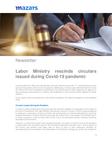
Labor Ministry rescinds circulars issued during Covid-19 pandemic
In this regard, below we present the most relevant aspects of the decision adopted by this ministerial office.
Circulars issued during the Pandemic
In order to protect employment and guarantee the economic stability of companies in the context of the Covid-19 pandemic, the Labor Ministry had issued a series of circulars in which it gave guidelines to employers, contractors, workers and labor risk administrators or offered alternatives to avoid the massive dismissal of workers and thus guarantee the right to work of thousands of Colombians who, on many occasions, could not leave their homes due to the preventive isolation decrees issued by the National Government.
However, currently the situation has changed drastically, the cases of COVID-19 have decreased to a great extent, the vaccination goal for the Colombian population has been met in many regions of the country and workers have been able to return to work at their employers' facilities, all accompanied by the elimination of the declaration of the Sanitary Emergency, previously ordered by the Health Ministry, and the Decree of Economic, Social and Ecological Emergency issued by the National Government. Likewise, some of the alternatives provided by the Labor Ministry at the time to help preserve jobs, such as Work at Home, have now been formally regulated by law.
All these reasons led the Labor Ministry to eliminate those circulars that were no longer applicable or that could generate confusion or contradictions with the regulations in force. As a result, the following circulars were eliminated:
- Circular 017 of 2020: Established the minimum guidelines for employers, contractors, workers and occupational risk management companies regarding promotion and prevention for the preparation, response and attention to cases of COVID-19 disease.
- Circular 021 of 2020: This Circular presented various alternatives that employers could implement for employment protection.
- Circular 022 of 2020: By means of which the Ministry of Labor adopted the figure of Rigorous Labor Inspection to strictly exercise inspection, vigilance and control of the decisions adopted by employers in the context of the pandemic.
- Circular 027 of 2020: With which employers were prohibited from coercing workers to take unpaid leave.
- Circular 033 of 2020: Presented additional alternatives to those indicated in Circular 021 of 2020 for the protection of employment.
- Circular 041 of 2020: Dictated the guidelines to be followed by employers, workers and Labor Risk Administrators for the implementation of work at home.
It is worth mentioning that, although these circulars are no longer in effect, some of their provisions should continue to be implemented insofar as they are applicable and do not go against the labor regulations in force. Let us take as an example the guidelines of Circulars 021, 027 and 033 of 2020. The alternatives established in Circulars 021 and 033, excluding some such as those related to work at home whose conditions for their implementation have changed, may continue to be applied in the event that the employer wants to modify the time or way of performing the work by the employee, only that it is no longer mandatory to apply or exhaust them prior to terminating the employment relationship, since at present the employer can dismiss the employee without just cause as long as it pays the respective compensation as established in the Substantive Labor Code.
Regarding the elimination of Circular 027, this should not be understood as an authorization by the Labor Ministry for employers to coerce their employees to take unpaid leaves of absence, since this would go against constitutional and legal principles, but rather as the possibility that such leaves may, in addition to coming from a prior request of the employee, be agreed by mutual agreement without the Inspectors deploying a rigorous control for these cases.
Elimination of Circular 049 of 2019
Another of the Circulars that was left without effect, although for different reasons than those mentioned above, was Circular 049 of 2019. In this one, the Labor Ministry had defined the guidelines to be followed by Labor Inspectors when studying requests for authorization to dismiss workers in a situation of disability or with reinforced labor stability for health reasons, setting such guidelines in 4 assumptions:
- When the employer requests the termination of the relationship and states that there is just cause for dismissal.
- When the employer requests the termination of the relationship and states that there is an objective cause.
- When the disability or health situation of the employee is incompatible and insurmountable with the position he/she performs.
- When the employer requests the termination of the labor relationship but does not allege just cause for dismissal or objective cause, nor proves to have exhausted the process of reincorporation of the disabled employee.
In the first three cases it would be up to the inspector, prior to the approval or rejection of the authorization, to verify a series of documents and evidence that would demonstrate the existence of a just or objective cause to terminate the employment contract or the fulfillment of its obligations regarding Occupational Safety and Health when the disability was incompatible and insurmountable. Only in the fourth case would the inspector always deny the authorization to terminate the contract.
All these guidelines were rendered null and void because, as indicated by the Labor Ministry in its circular, these guidelines were issued without the participation of employees and union organizations and associations of workers in conditions of manifest weakness, thus violating their right to participate in the decisions that affect them.
At this point, it is worth remembering that Circular 049 was criticized by some workers' associations and union organizations. In fact, the legal team of the National Labor Union School had stated at the time that this circular:
- It established discriminatory treatment for those workers whose contract was terminated due to the expiration of the work or labor contracted and who had acquired a disease prior to the labor relationship, since the circular only established guidelines for those who had acquired the disability during the term of the labor relationship.
- It did not take into account the state of vulnerability of the employee at the time of studying the authorization of dismissal, limiting the work of the labor inspector to the review of documents.
- It jeopardized the labor guarantees of those workers whose illness was incompatible and insurmountable with respect to their position.
Finally, it should be clarified that the elimination of this circular does not mean that employers cannot terminate the relationship of a employee with reinforced labor stability for the reasons indicated above if they have the respective authorization, but it is possible that the Labor Inspectors do not have the necessary clarity regarding the documents they must review or the scope of their functions at the time of studying the requests for authorization of dismissal in these cases. For this reason, it will be the Labor Ministry's responsibility to issue a new circular as soon as possible, reconciling the needs of both employers and employees, with the active participation of workers' associations and union organizations.



